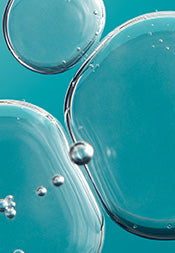Is Your Cell Phone’s Blue Light a Skin Concern?
The science of natural light and how it interacts with people and the world around us is fascinating and complex. Research has established that even though UV light is invisible, it poses significant risks to our skin. But the sun also emits visible light, a portion of which is known as blue light.
Researchers have known for some time that blue light from the sun can harm skin and eyes, but...are you sitting down? Blue light also emanates from most digital devices, including your smartphone and computer, where the damage is up close and personal. Read on to find out what you can do to stop blue light damage to your skin.
Blue light and UV light explained
When you look at a chart about the sun’s damaging UVA and UVB rays, you’ll see that their wavelengths range from 280 nm to 400 nanometers (nm). Next on the spectrum is blue light, defined as light with wavelengths ranging from 380 nm to 500 nm. The entire light spectrum goes up to 700 nm.
The blue light portion is what emanates from digital devices, such as computers, tablets, flat screen TVs, fluorescent light bulbs, and smartphones. Both types of UV rays and blue light are bad for your skin and eyes, but there are steps you can take to reduce these skincare risks and concerns.
Is blue light a danger to your skin?
Evolving research has shown that blue light can be bad for skin. It’s certain that blue light in the 380–400 nm range is problematic, although the concern seems to lessen somewhat toward the top end at 500 nm.
Long-term exposure to concentrated sources of blue light energy can cause skin damage, including colour changes, inflammation, and weakening of the skin’s surface. Simply put, blue light promotes stressors in the skin that cause photo-aging; that is, aging from exposure to light.
How can you tell if blue light has damaged your skin?
As with many forms of light exposure, the damage you suffer from blue light isn’t necessarily immediately noticeable. Unlike sunburn – where the cause for concern is obvious at the outset – blue light damage is cumulative, occurring over time. It might take years to see the visible results, which include fine lines, wrinkles, uneven skin tone, and premature skin aging in general.
The difference between blue light exposure from UV and blue light from screens
Without question, sunlight is the main source of blue light to which we are exposed; digital devices emit only a fraction of that amount of radiation. A major difference is that our phones are much closer to us than the sun, and this “close-up” exposure matters. In contrast, blue light UV is more diffused and much further away.
We spend so much time using our devices, holding them close to our face and eyes, and when it adds up—that’s where health and skin concerns may arise. Statistics show that millennials check their smartphones 157 times per day, in comparison to older adults, who check their phones only about 30 times per day, meaning that the former are at a much higher risk of blue light exposure causing skin damage.
When it comes to the eyes, there’s far more research indicating how damaging unprotected exposure to blue light from the sun can be. Current opinion on eye damage from blue light coming from digital devices is mixed, but many eye health professionals claim it’s too weak to be a problem. What’s certain is that nighttime exposure to blue light from smartphones and the like disturbs our body’s natural sleep/wake cycle, known as its circadian rhythm. This disruption can lead to several health issues, including weight gain, poor-quality sleep and dull, tired skin.
The research into blue light damage to the skin is less conclusive but still concerning, with many experts recommending precaution over complacency.
Blue light protection for your skin and eyes
A simple solution for blue light protection is to cover your phone and tablet with a blue light screen shield. It’s a cheap fix, eliminating the need for concern regarding additional skincare or sunglasses when using your phone or tablet (if only it were that easy for your skin and the sun).
Another option: Some smartphones, tablets, and laptops have a setting that disables blue light in favour of yellow light (often called night mode or nightshift) which is far easier on the eyes—and, in turn, your skin. If your phone has this feature, setting it to be on all the time can be a great anti-aging and eye-saving thing to do. It will probably improve your sleep, too, and who doesn’t want that?
Whether it’s the light from sun exposure or from your smartphone, without question, you need to protect your eyes during the day. Polarised sunglasses are essential for all outside light exposure to prevent long-term damage as well as damage from your phone. Unless your doctor prescribes a blue light facial treatment, you also need to protect your skin from potential damage due to exposure to this light.
Can you undo blue light damage to the skin?
In terms of “fixing” blue light damage, the best way to take care of it also happens to be the best way to prevent it. Look for serums loaded with antioxidants and consider a skincare routine formulated with proven ingredients to address the visible effects of normal airborne pollutants. Although blue light isn’t the same as smog, both cause unwanted skin concerns, including dull, tired skin and uneven skin tones. Last, always apply an antioxidant-loaded broad-spectrum sunscreen to shield your skin from the most concentrated portions of UV and blue light.
Find out more advice about aging skin today.
Visit our online store for our range of highly raved skincare products suitable for you.
References for this information
International Journal of Cosmetic Science, December 2019, pages 558-562
Journal of Biomedical Physics and Engineering, December 2018, pages 447-452
Photodermatology, Photoimmunology, and Photomedicine, May 2018, pages 184–193
Journal of Investigative Dermatology, January 2018, pages 171–178
Free Radical Biology & Medicine, July 2017, pages 300–310
International Journal of Ophthalmology, February 2017, pages 191–202
Dermatologic Surgery, June 2016, pages 727–732; and September 2014, pages 979–987
Molecular Vision, January 2016, pages 61–72
Journal of the American Academy of Dermatology, September 2015, pages 526–528
Journal of Occupational and Environmental Hygiene, January 2015, pages 603–610
Free Radical Biology and Medicine, July 2015, pages 373–384
Journal of Biomedical Optics, May 2015, #58001
Environmental Health Perspective, March 2014, pages 269–276
Photodermatology, Photoimmunology, and Photomedicine, February 2010, pages 16–21












